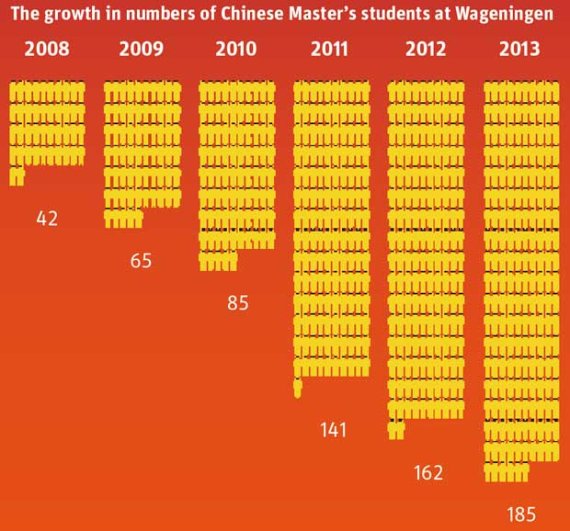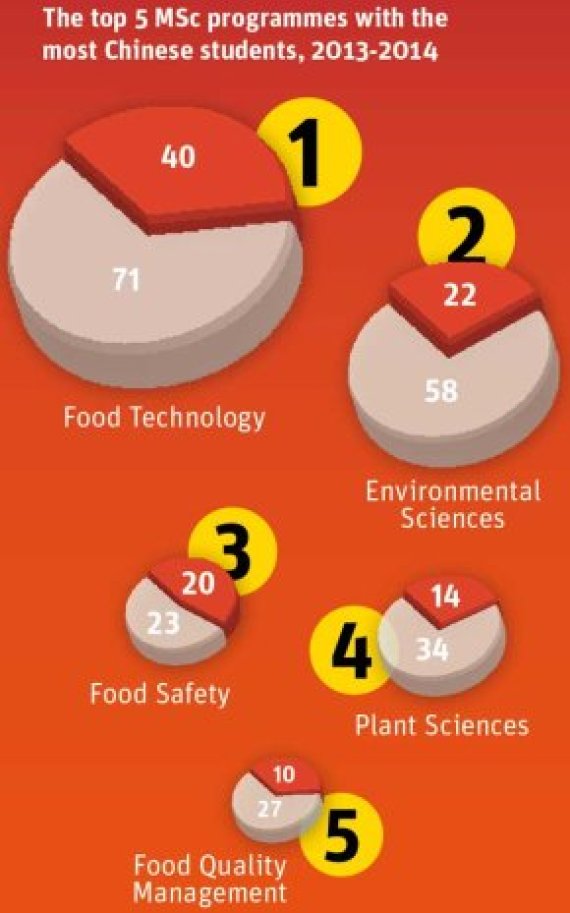You will notice the change at once if you have not been on campus for a few years. What a lot of Chinese! That is not just an impression — the figures show it really is the case. To get straight to the point: there are 536 Chinese students in Wageningen. Or 385 Master’s students, 148 PhD students and 3 Bachelor’s students, to be precise. That puts China far ahead of the other countries of origin for our international students. But absolute numbers are not everything. A much more significant factor is the growth, which was meteoric a couple of years ago and is about 15 percent a year now. One in every ten Master’s students is Chinese and they make up a quarter of all international Master’s students. The numbers on some Master’s programmes are rising to somewhat worrying levels. Half the Food Safety students are Chinese and a third of the Food Technology and Food Quality Management students come from China. There is even concern about the dominance of a single foreign nationality and a special working group (The International Classroom) is investigating whether measures should be taken. Rien Bor is one of those responsible for the recruitment of international students. He has a global network that he built up himself with 25 representatives. These are alumni who promote Wageningen for a fee after returning to their country of origin. They give information about Wageningen, hold talks at education fairs and act as a point of contact for interested candidates. Bor’s system is unique in the Netherlands and has served Wageningen well. The number of Chinese preliminary registrations for the next academic year currently stands at 486 already. ‘I expect to end up with about 600, of whom about 200 will eventually study here.’

The crowds in Wageningen are not an isolated phenomenon as large numbers of Chinese choose to study abroad. According to figures from Nuffic, a total of 645,000 Chinese were enrolled at foreign higher education institutions in 2011, 60 percent more than five years earlier. Most Chinese study in the US, or Japan and Australia, which are relatively close by. There were about 149,000 Chinese students in Europe in 2011, most of them in the United Kingdom, France and Germany. The Netherlands is a minor player on the global and European scene. Nuffic’s figures show that 6910 Chinese studied here last year, of whom 2395 at an academic university. Delft attracts the most students, closely followed by Wageningen, Tilburg and Rotterdam. However, Wageningen has the highest proportion of Chinese students. Many of them choose a degree in nutrition. Bor says that is not due to a government strategy. ‘Food safety and food security are a big problem in China,’ says Bor. ‘Students are aware of that and that explains their preference for nutrition and the environment. But I don’t think it’s a specifically Chinese thing. You see the same thing in other countries with similar pro-blems.’
Expensive
China itself has about 75 agricultural universities. Five of them operate at the national level. Wageningen has good contacts with three Chinese universities: China Agricultural University (CAU, Beijing), Nanjing Agricultural University (NAU) and Northwest A&F University (Yangling). Most Chinese students in Wageningen come from the east coast, the wealthiest part of the country. Chinese who go abroad for their Master’s have to pay for their own costs. Two years spent studying in Wageningen can easily cost 50,000 euros.
Sources
:
Internationalisering in beeld, 2013 (Nuffic)Education Monitor 13/14 (Wageningen UR)Quality & Strategicv Information (Corporate ER&I, Wageningen UR)

